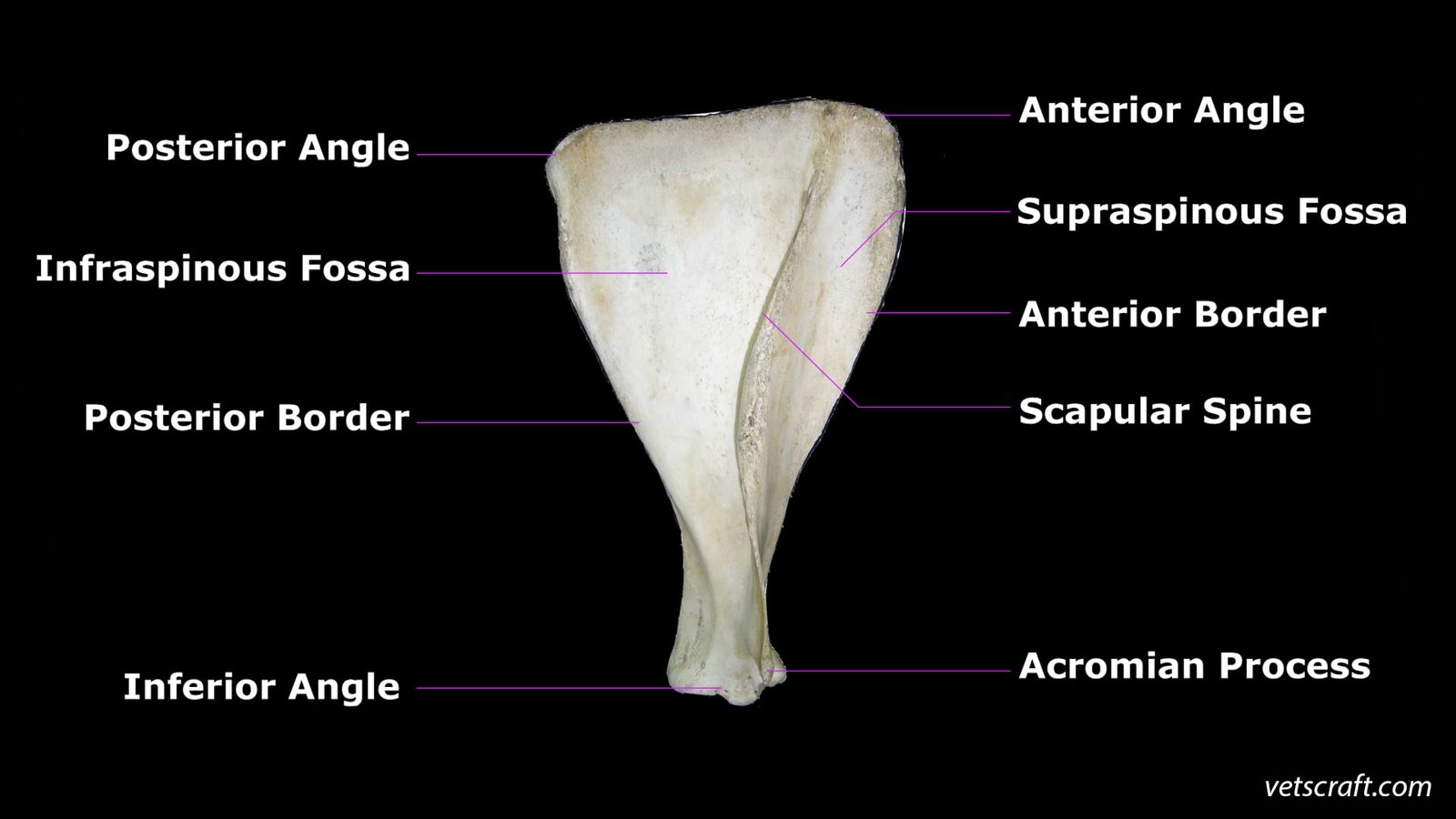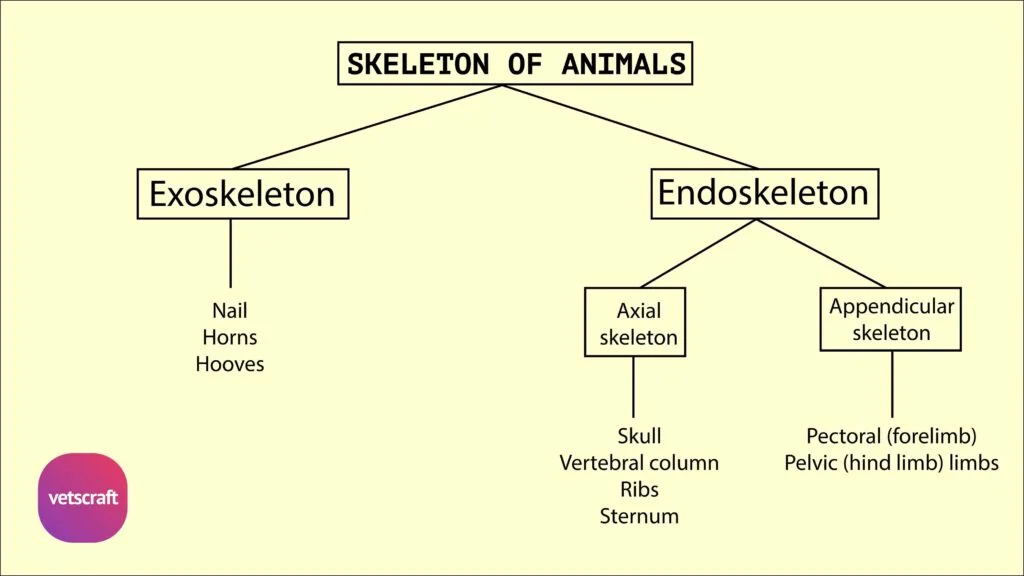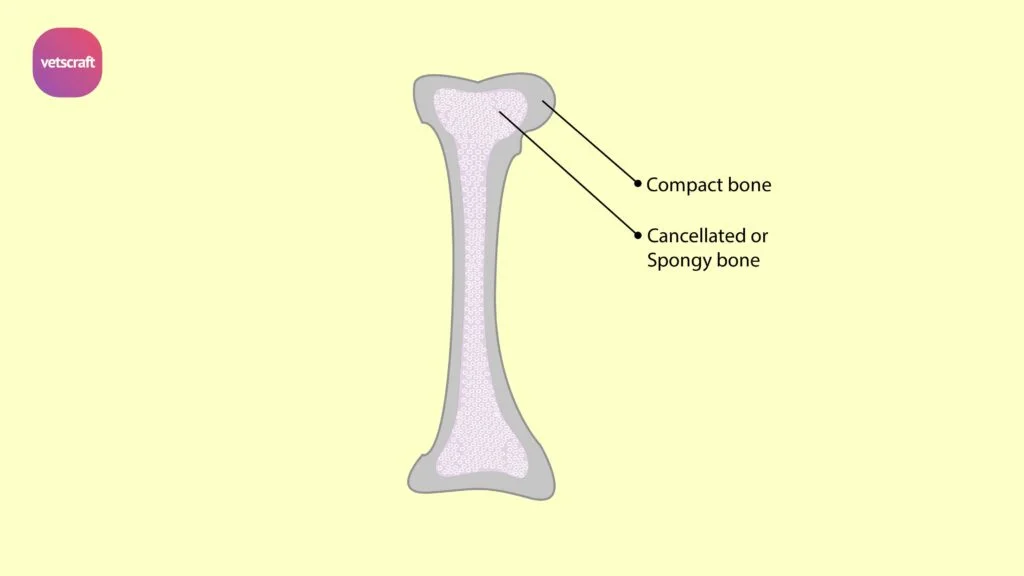TABLE OF CONTENTS
Scapula Bone of Domestic Animals
The scapula bone, also known as the shoulder blade, is a flat, triangular bone located on the lateral side of the thorax in domestic animals. It serves as a major component of the pectoral girdle, providing attachment sites for several muscles involved in limb movement and supporting the forelimb without forming a direct joint with the axial skeleton (except in birds).


Comparative Anatomy of Scapula in Domestic Animals
Here is an explanation of the scapula (shoulder blade) bone in different domestic animals, presented one by one, highlighting species-specific features that are relevant in comparative anatomy:
Ox
The scapula of the ox is a flat, triangular bone situated on the anterolateral aspect of the thorax and directed obliquely downward and forward. The clavicle is absent. It is connected to the axial skeleton only by muscles. It has two surfaces, three borders, and three angles.



The lateral surface, or dorsum, is wide above and narrow below. It is traversed by the scapular spine, which divides the lateral surface into a cranial supraspinous fossa and a caudal infraspinous fossa, the former being smaller. The free edge of the spine is largely subcutaneous, somewhat rough, and tuberous in the middle for the attachment of the trapezius, and it is prolonged downward to form the acromion process for the deltoideus muscle. The supraspinous fossa lodges the supraspinatus muscle. The infraspinous fossa is occupied by the infraspinatus, and the muscular ridges at its lower part serve as the origin for the teres minor.
The costal or ventral surface presents a shallow depression called the subscapular fossa, which lodges the subscapularis. The upper third of this surface presents, cranially, a triangular rough area for the serratus cervicis, and posteriorly, a rough line for the serratus thoracis.
The cranial border is thin, convex above and concave below. The caudal border is thick, presents the nutrient foramen in the lower third, and is rough for deltoideus, teres major, and long head of triceps muscles. The vertebral border is thick, pitted, and carries in life the scapular cartilage, the unossified part of the fetal scapula. The medial face of the cartilage gives attachment to the rhomboideus.
The cranial or cervical angle is thin. The caudal or dorsal angle is thick. The ventral or glenoid angle carries the glenoid cavity, and cranial to it the tuber scapulae. The former meets the head of the humerus to form the shoulder joint. The rim of the cavity presents the glenoid notch on the craniolateral aspect. The tuber scapula is for the biceps brachii and presents the coracoid process on its medial aspect for the coracobrachialis.
Sheep and Goat
The vertebral border of the scapula of sheep and goat is longer, and the neck is narrower. The scapular spine is less tuberous.
The inferior or glenoid extremity is relatively longer, since the tuber scapula is connected with the rim of the glenoid cavity. The rim of the subscapular fossa is extensive.
Horse
The acromion process is absent in the scapula of the horse. The subscapular fossa is deeper and partly separates two triangular rough areas in the upper third.
The glenoid notch is on the anteromedial aspect of the rim. On its posterolateral aspect, the rim presents a tubercle for the teres minor. The tuber scapula is larger and placed further away from the glenoid cavity.

Pig
The scapula of the pig is very wide, and the scapular spine is triangular and very wide in its middle, which curves backward over the infraspinous fossa and bears a large tuberosity called the tuber spine.
The acromion process is rudimentary. The cranial border is slightly convex, thick, and rough in its middle. The caudal border is wide and slightly concave.
The vertebral border is convex, and the scapular cartilage is not as extensive as in the horse and ox.
The cranial angle is thin and bent medially. The caudal angle is thick and is at a right angle. The glenoid notch is absent.
The tuber scapula is above the anteromedial part of the glenoid cavity. There is no distinct coracoid process, and it unites with the rest of the bone at about one year.
Dog
The clavicle, when present, is a small cartilaginous or bony plate embedded in the brachiocephalicus muscle, in front of the shoulder joint, and does not articulate with the rest of the skeleton.
In the scapula of the dog, the spine is placed in the middle of the dorsum and increases in height from above downward to the level of the glenoid cavity, where it terminates in the acromion process.
The vertebral border is convex, and the scapular cartilage is in the form of a thin band. The glenoid cavity extends to the inferior face of the tuber scapula. The coracoid process is absent.
Rabbit
The coracoid process of the rabbit appears as a slight enlargement at the cranial part of the rim of the glenoid cavity. The scapular spine possesses, distally, an elongated caudal process—the metacromion process—along with the acromion process.
Fowl
The scapula bone of the fowl includes a clavicle, coracoid, and the scapula.
The clavicle is a thin, bent rod directed downward and backward. The flat dorsal end rests against the scapula and the coracoid to form the foramen triosseum. The clavicles of both sides unite ventrally to form a flattened plate called the hypocleidium, which is attached to the rostrum of the sternum by a ligament. The two combined clavicles form the furcula, also called the “wishbone.”
The coracoid is rod-like, directed backward, downward, and inward. The upper extremity is prolonged into a hook-like process medially. It presents a small articular surface—the glenoid cavity—for articulation with the humerus. Below this, there is another area for articulation with the scapula. The lower extremity articulates with the sternum.
The scapula is a narrow, saber-shaped bone placed parallel to the vertebral column. The anterior end presents a depression laterally, which forms part of the glenoid cavity for the reception of the head of the humerus, and a projection cranially—the acromion process—which meets the clavicle and coracoid to form the foramen triosseum. The posterior end lies at the level of the sixth rib.

Frequently Asked Questions
It serves as a site for muscle attachment and supports forelimb movement without directly articulating with the spine (except in birds).
The horse lacks an acromion process.
The fused clavicles in birds form the furcula, commonly known as the “wishbone.”
The ox has the most prominent scapular cartilage, which is unossified and provides attachment to the rhomboideus muscle.
The scapular spine is a prominent ridge on the lateral surface of the scapula that divides it into the supraspinous and infraspinous fossae for muscle attachment.
The scapula of a dog has a well-developed acromion process, while the horse’s scapula lacks an acromion. The overall shape is also narrower and more curved in dogs.
Several muscles attach to the scapula including the supraspinatus, infraspinatus, deltoideus, trapezius, and rhomboideus, facilitating limb movement and stability.
The supraspinous fossa is the area above the scapular spine where the supraspinatus muscle originates.
No, not all animals have well-developed clavicles. For example, the clavicle is absent or rudimentary in domestic animals like cattle and horses but well developed in birds and cats

